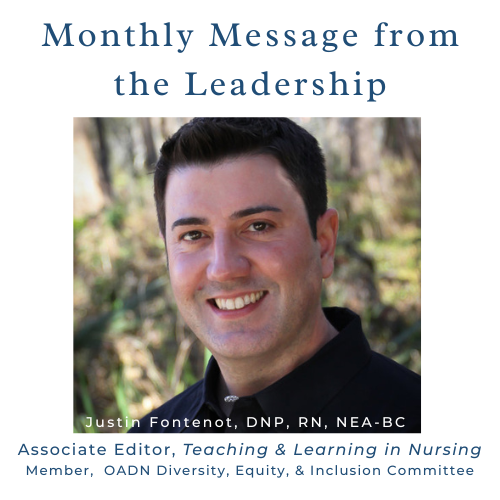October 3, 2022

In January 2021, the American Nurses Association (ANA) launched the National Commission to Address Racism in Nursing. The commission’s primary goal is to explore racism in nursing and its devastating impacts across the expansive nursing profession. Donna Meyer, the Chief Executive Officer at the Organization of Associate Degree Nursing (OADN), represented associate degree nursing (ADN) as a commission member among a diverse panel of organizations, nurse leaders, and scholars. Dr. Anna Valdez, the Editor in Chief at OADN’s journal Teaching and Learning in Nursing, served as a content expert in nursing education for the commission. In May 2022, the commission released its foundational report entitled Racism in Nursing because of the work of the commission members. You can review the report here.
In June 2022, the ANA’s official voting body at its Membership Assembly voted unanimously to approve a statement on racial reckoning. This historic statement marks the start of a journey that begins with acknowledging the ANA’s own role in limiting the engagement of nurses of color in organizational participation. We encourage all OADN members to read the statement here.
Of significance to nursing education, particularly the associate degree pathway to practice entry, the ANA statement acknowledges the exclusionary harm in its 1965 position paper recommending that the standard for practice entry be the Bachelor of Science in Nursing (BSN) degree (American Nurses Association [ANA], 2022). The ANA also acknowledges that the decision to accept such a position statement was contextual and addressed the growing complexity of nursing care at the time. The ANA recognizes how this impacted the nurses’ ability to enter the profession—namely, historically and intentionally marginalized people. They concede that while the intention was to elevate the profession, they did not ensure equal access to education for all who wish to enter the profession. Further, the ANA calls for exploration of how this position impacted nurses and calls for a commitment to scholarship and action to ensure access to everyone, especially students of color.
As the primary organization advocating, advancing, and representing associate degree nursing programs and community colleges, OADN commends the acknowledgment of ADN preparation in the ANA reckoning statement. The 1965 ANA position paper impacted the associate degree entry to practice. Still, OADN has always supported, advocated, and uplifted the ADN pathway into nursing practice and will continue to do so well into the future! For example, in 2015, OADN released a joint position statement with the ANA to address academic progression. In the position statement, all represented organizations “affirmed the valuable contribution of community colleges in providing opportunities for entry into the nursing workforce by individuals with diverse racial and ethnic backgrounds and socioeconomic statuses” (ANA, 2015, p. 2). As a result, the position paper highlighted several new models for protecting the ADN entry to practice and unique and emerging models to ensure student success in academic progression. Today we see many of these models supporting educational advancement like the RN to BSN, community colleges awarding the BSN degree, and partnerships for concurrent enrollment to progress to the BSN following the conferral of the ADN.
The National Education Progression in Nursing Collaborative (NEPIN) is an initiative supporting the academic progression to the BSN while leveraging the foundation of the ADN pathway. The organization provided a first-ever look at educational advancement, releasing a report entitled Trends in Nursing Academic Progression 2016-2020. During the study period, the data revealed that 65% of new nursing students chose the ADN pathway into the profession (NEPIN, 2020). Additionally, the data showed a 23% increase in ADN graduates enrolled in a BSN program (NEPIN, 2020); and probably the most profound finding; the report states, “ADN graduates subsequently enrolling in BSN programs account for much of the diversity seen in the BSN programs” (NEPIN, 2020, p. 10).
OADN is hopeful that the reckoning statement from the ANA related to ADN education will continue to elevate the discussion, highlighting this pathway’s critical importance in the United States nursing workforce. Now more than ever, specifically in a post-pandemic world, the ADN is vital in addressing ongoing nursing shortages at the bedside and the exigent need for workforce diversity.
* Dr. Justin Fontenot, DNP, RN, NEA-BC, serves as Associate Editor of Teaching and Learning in Nursing and is a member of the OADN Diversity, Equity, & Inclusion Committee. Dr. Fontenot is nurse faculty at the University of Louisiana of Lafayette and South Louisiana Community College.
References:
American Nurses Association. (2015). Academic progression to meet the needs of the registered nurse, the health care consumer, and the U.S. health care system. https://www.nursingworld.org/practice-policy/nursing-excellence/official-position-statements/id/academic-progression-to-meet-the-needs-of-the-health-care/
American Nurses Association. (2022, June 11). Our racial reckoning statement. https://www.nursingworld.org/practice-policy/workforce/racism-in-nursing/RacialReckoningStatement/
National Education Progression in Nursing Collaborative. (2020). Trends in nursing academic progression. https://nepincollaborative.org/wp-content/uploads/2021/11/NEPIN_AcademicProgressionTrends_2016-2020_Final.pdf